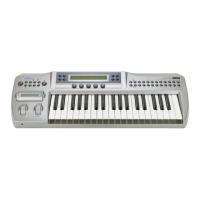30
4.3
Saving
a
program
Programs can be saved in bank A
00-63,
bank B 00--63,
and
if a writable card
is
inserted, bank CARD
00~
63.
In Performance mode,
~:hanges
you make to the
sound
using the Performance Editor,
and
the
on/
off
status
of the PORTAMENTO key can be saved for each program. Each program also contains the settings
made
in Edit
mode
(excepl: for the Global section settings)
and
all settings of Performance Editor Define.
These settings are not saved in memory unless you perform the Write operation. In the Edit
mode
Global
section, changes
you
make are saved at the moment they are modified, so there
is
no need to Write them
into memory.
Ten arpeggio patterns can
be
saved in
bank
INT PAT,
and
if a writable
card
is inserted, the CARD PAT
bank
can accommodate ten
more
patterns. However, it is
not
possible to write directly into the CARD
PAT bank. The UP, DOWN ALTl, ALT2
and
RANDOM patterns can save arpeggio parameters. PATl-
-P
A
TS
can save arpeggio parameters
and
also pattern parameters. As with the Edit
mode
Global section
parameters,
this
data
is
saved
at
the
moment
it
is
modified,
so
there
is
no
need
to Write
them
into
memory.
To
write
a program,
press
the WRITE
key
from
any
mode
or
condition.
• Memory protect
To
help
prevent
data
from
being
inadvertently
overwritten,
the
Global section contains a
memory
protect setting. Before writing data that
you
create, you
must
turn
off the memory protect setting in the
Global section.
iJl
Press
the
PERFORMANCE/EDIT Select key to
enter
Edit
mode
(the
lower
LED will
blink).
[!} Press the GLOBAL key to enter the Global section. Use the PAGE keys to
move
to
page
GLB-20 [Memory Protect].
If
you
wish
to
edit
and
write a
program,
rotate knob 2 to
turn
Program
Memory OFF.
If
you
wish
to
edit
arpeggio parameters, rotate knob 4 to
turn
Pattern Memory OFF.
*
When
you
write
data,
the
data
that
was
previously
in
the
writing
destination
will
be
lost.
However,
you
can
use
Global
section
page
GLB-19
[Load
Factory
Data]
to
restore
the
sounds
that
the
Prophecy
was
shipped
with.
Global
section
settings
and
arpeggio
parameter
settings
can
also
be
restored
to
the
factory
settings.
•Rename
Here's
how
to assign a
new
name
to a
program
you
have edited.
[!) Press the PERFORMANCE/EDIT Select
key
to
enter
EDIT
mode
(the
lower
LED will
blink).
[!} Press
the
COMMON
key to enter
the
Common
section. Use
the
PAGE keys to move to
page
CMN-1 [Program Name].
rm
Press the CURSOR keys
or
rotate knob 4
and
make sure
that
the cursor appears.
When the cursor appears,
you
can modify the character
at
the location of the cursor.
@I
Use the CURSOR
k~eys
or
knob 4 to
move
the cursor,
and
use the VALUE keys
or
knob 5
to select a character.
At
this time
you
can
press
the ENTER key to
input
a space,
or
the
EXIT
key to delete a character.
r:w
Use
the
PAGE keys to
move
to
page
CMN-2 [Prog Category]. Use knob 1 to select the
program
category.
The
Program
Category allows
you
to classify
your
programs
by
sub-name
or
type
of sound. The
Program Category is displayed at the right of the
program
name
in Performance mode.
When
selecting
programs
in Performance
mode,
you
can use the PAGE keys to find
and
select
programs
that
have
the same category.

